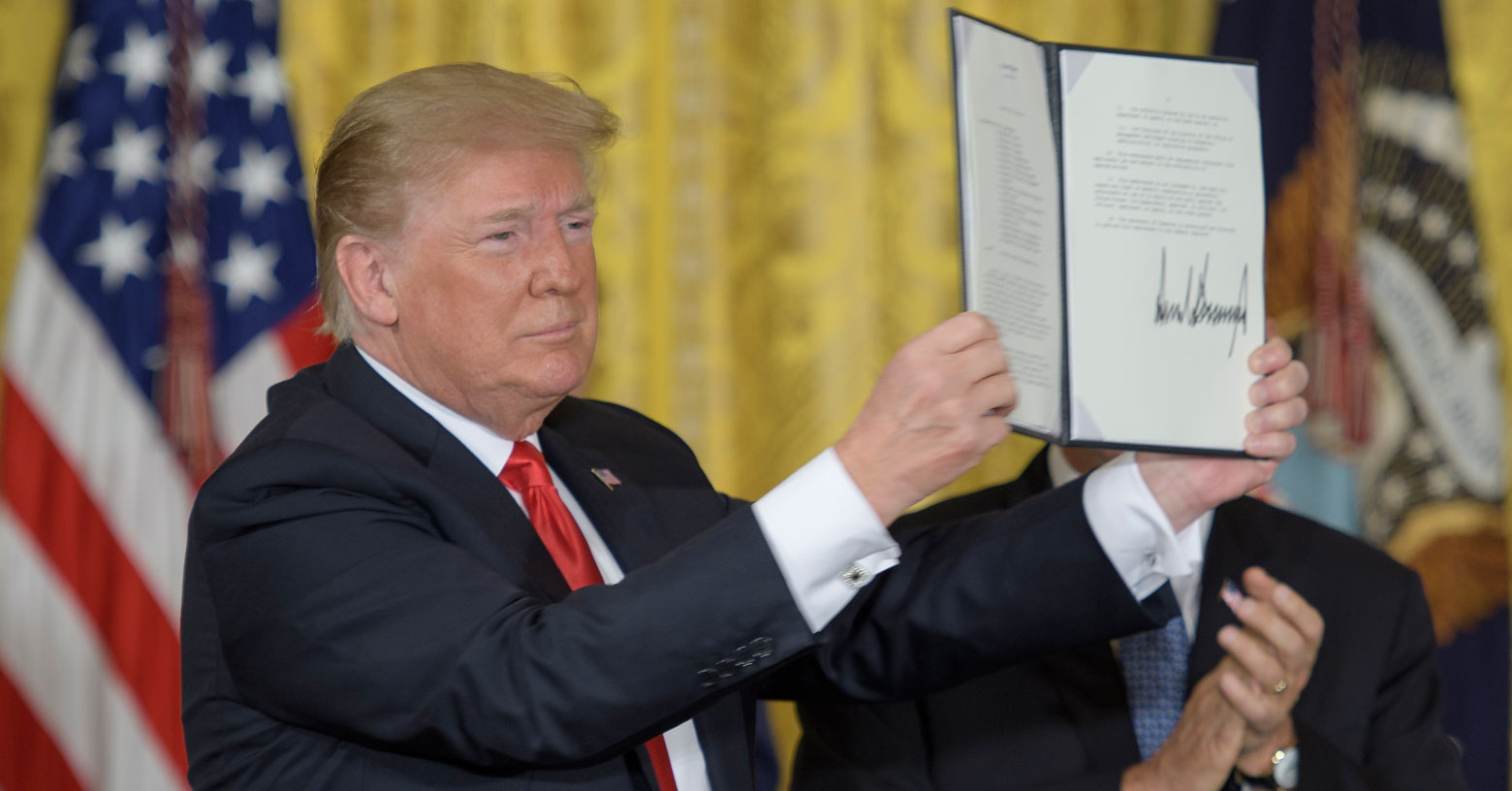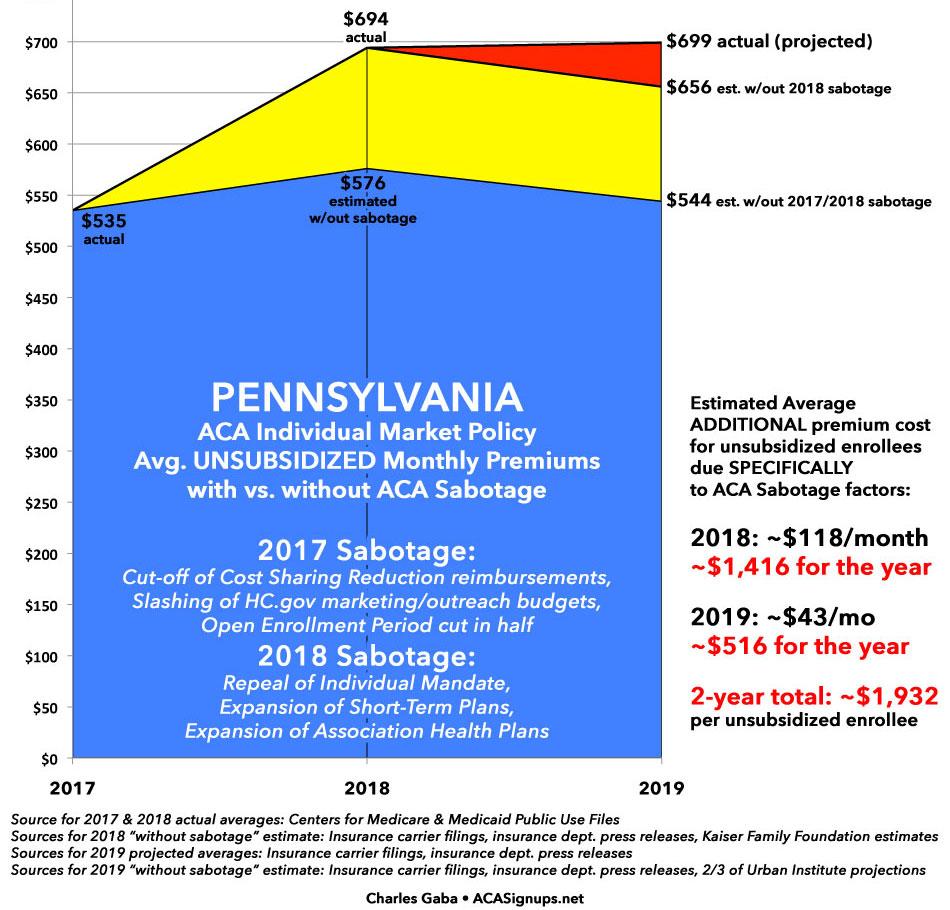
A few weeks ago, healthcare analysts at the Center for American Progress (CAP) posted a detailed analysis of just how much more unsubsidized enrollees in ACA-compliant individual market healthcare policies will have to pay next year than they'd otherwise have to due specifically to sabotage efforts by the Trump Administration and Congressional Republicans.
Notice that I didn't say "how much more" ... I said "how much more than they'd otherwise have to."
As I explain in this blog post, that exact wording is important because the 2019 ACA premium situation is quite different from past years. In 2018, premiums increased by a massive 28 percent or so, with most of that being due specifically to Donald Trump cutting off contractually required Cost Sharing Reduction reimbursement payments, along with a mish-mash of other efforts to undermine the law, such as slashing the marketing budget by 90 percent, cutting the outreach/navigator budget by 40 percent and so forth.
In 2019, however, average premiums are only going up about 4 to 5 percent on average compared to this year ... and in some states are actually dropping. This makes attacking Republicans and Trump for "huge rate hikes!" more difficult, since the sabotage effect (mostly due to the individual mandate being repealed and the expansion of non-ACA compliant short-term and association plans) is less obvious.
Expect Republicans to jump on this message … pooh-poohing the idea that their sabotage is causing painful rate increases by pointing to that average of 4 to 5 percent. This article already posits that conclusion and says media is ignoring this "great" news about a tiny increase.
This definitely presents a problem for Democrats who were hoping to hang rate increases on Republicans in the midterms. It would have been a lot easier for them to make this attack by saying “premiums went up 28 percent instead of 10 percent because of sabotage!” …than it is to say “premiums went up 8 percent instead of down 2 percent because of sabotage!”
But if Democrats want to capitalize on sabotage, that’s what they’ll need to do: They need to explain to voters that
- Sabotage caused a huge increase in 2018
… and …
- Sabotage is continuing to cause premiums to increase in 2019
… when …
- Without sabotage, premiums would have ... on average ... decreased.
The price of sabotage in Arkansas
Want an example of what I’m taking about? Let's look at Arkansas:
The average Arkansas ACA enrollee is paying around $509/month this year. Rates are expected to increase by just 4.5 percent on average in 2019 ... but if the individual mandate hadn't been repealed and the floodgate on non-compliant short-term plans wasn't being opened, I estimate rates would be dropping by around 8 percent instead.
That means instead of dropping to $468/month, enrollees will have to pay around $532/month next year ... a difference of $768 per year.
This graph shows the difference for unsubsidized buyers. (Cha-ching!)

In Arkansas, 2018 premiums increased 20 percent, with about half of that being sabotage-related. In Pennsylvania the situation is a bit different: Average premiums increased by 30 percent, with nearly three-fourths of that being sabotage-related.
By contrast, in 2019, Arkansas rates are going up 4.5 percent, while in Pennsylvania they’re expected to remain nearly flat … but again, they would have dropped by around 5 to 6 points if not for the mandate being repealed and short-term plans being expanded.
 Is it the same story across the country? It’s not: The numbers vary widely from state to state and even from district to district.
Is it the same story across the country? It’s not: The numbers vary widely from state to state and even from district to district.
But here’s what jumped out at me as I was reviewing these numbers:
1. Red states are getting screwed by sabotage
The states which seem to be facing the biggest sabotage price hike (over $1,000 per enrollee) are, perhaps not surprisingly, all red states (except for Virginia): Alabama, Arizona, Nebraska, North Dakota, Oklahoma, South Dakota, Tennessee, West Virginia, Wisconsin and Wyoming. Tennessee was briefly looking at over $1,500 per enrollee before the Risk Adjustment Freeze situation was resolved last week; now it's down to "only" around $1,100 apiece.
2. States that are sidestepping sabotage are OK
- Three states should have no net 2018 sabotage impact at all, although one of these is questionable. Massachusetts never repealed their pre-ACA individual mandate in the first place, and New Jersey has reinstated theirs. These states are looking at increases of 4 percent and 5.8 percent respectively ... but if you removed the mandates, those numbers would likely be 5 to 10 points higher. Both have also either eliminated or seriously restricted short-term plans.
- The states with the lowest sabotage impact appear to be California, Rhode Island and Vermont (none of which are surprising, as all three have highly regulated markets and insurance departments which take a very hands-on approach). I estimate California at an extra $230/year, Vermont at $232 extra and Rhode Island at a nominal $50/year. For whatever reason, Rhode Island's two carriers seem pretty confident that mandate repeal will only have a nominal impact next year: One didn't bake anything extra into their prices, while the other is only bumping rates up 1.9 percent because of it.
3. States that are mitigating sabotage could be in better shape
- Several states have implemented a reinsurance program which has either already led to dramatic rate reductions (Alaska and Minnesota) or which have staved off significant hikes (Oregon). Several more states are about to implement these programs, including Maine, Wisconsin, New Jersey and ... just this week ... Maryland. It's important to note that while these reinsurance programs have to be approved by the federal government, they have to be instigated by the state, which also has to do all of the legwork on them first. The thing is, reinsurance is separate from mandate repeal and/or expansion of short-term or association plans. All of these states should really reinstate the former and crack down on latter. New Jersey has done both; Maryland has done the second.
- Related to this: Maryland's 2019 rates are currently expected to jump a whopping 29.5 percent, the highest year-over-year increase in the country. Their recently submitted reinsurance waiver was just approved, which is expected to drop as much as 30 points for rates which will be effectively flat year over year … but again, this is separate from the mandate repeal issue. If Maryland were to also reinstate the individual mandate, they’d be able to knock another 5 to 10 points off the total.
Message is everything
The messaging on these $600+/apiece cost increases will be tricky to get across. For one thing, that’s ~$600 for the full year; it’s more like $50-$60 monthly, which is how people are generally used to looking at premium prices.
In addition, many of these states are actually seeing price drops next year, making it more difficult to say “but it would’ve dropped even more if Trump and the GOP hadn’t screwed with the law!” (even if that’s accurate).
In short, the “Sabotage-Created Premium Hikes!” attack is a legitimate one for Democrats to hit the GOP with … they just need to anticipate the GOP defense and immediately debunk it.
Beyond the message
And messaging obviously isn’t enough. While Democrats are explaining the costs of sabotage, blue states need to be actively working to counter it.
At the state level, there’s plenty which Democratically held legislatures and governorships can do … and as noted earlier, several states have already started doing so. Maryland, New Jersey and California in particular have been leading the way, with other states not far behind.
Charles Gaba is the founder of ACASignups.net, which has been live-tracking Obamacare enrollments since the exchanges launched in October 2013. His work has been cited by major publications from the Washington Post and Forbes to the New York Times as being the most reliable source available for up-to-date, accurate ACA enrollment data in the country.


